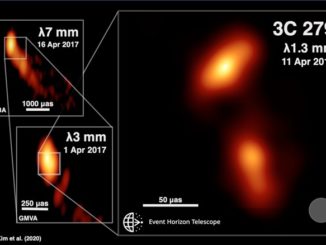
The Event Horizon Telescope captured the first image of a black hole, or rather the ring of light surrounding the black hole’s shadow. While the dramatic image, released last April, shows the diameter of the light ring – about 40 astronomical units – it does not have the resolution needed to determine its thickness or detailed substructure.
New calculations by researchers at the Institute for Advanced Study in Princeton New Jersey show future interferometers with longer baselines should be able to do just that, allowing astronomers to tease out a black hole’s mass, rotation and other details that are encoded in the precise size and shape of the photon ring.
“The image of a black hole actually contains a nested series of rings,” said Michael Johnson, a researcher with the Harvard-Smithsonian Centre for Astrophysics. “Each successive ring has about the same diameter but becomes increasingly sharper because its light orbited the black hole more times before reaching the observer.”
The EHT’s image of the black hole at the heart of the galaxy M87, unveiled in April 2019, provided “just a glimpse of the full complexity that should emerge in the image of any black hole,” Johnson said.

The theoretical analysis of how a black hole’s photon ring is formed by nested rings of light revealed new possibilities for for imaging.
“What really surprised us was that while the nested subrings are almost imperceptible to the naked eye on images, even perfect images, they are strong and clear signals for arrays of telescopes called interferometers,” says Johnson.
The Event Horizon Telescope is a globe-spanning array of radio telescopes acting together to form a huge virtual dish to provide the resolution needed to image the supermassive black hole at the core of M87. By adding an orbiting space telescope to that array, or placing an instrument on the moon, astronomers would increase the baseline and sharpen the resolution.
The animation below, provided by the Harvard-Smithsonian Centre for Astrophysics, shows how the photon ring is formed and hints at what future interferometers might reveal. The ring is made up of increasingly sharp subrings of photons that differ by the number n of half orbits around the black hole they complete on the way to an observer:
“Einstein’s theory of general relativity makes a number of striking predictions for the types of observations that are finally coming within reach, and I think we can look forward to lots of advances in the coming years,” said Daniel Kapec, a member of the IAS’s School of Natural Sciences.
“As a theorist, I find the rapid convergence between theory and experiment especially rewarding, and I hope we can continue to isolate and observe more universal predictions of general relativity as these experiments become more sensitive.”



